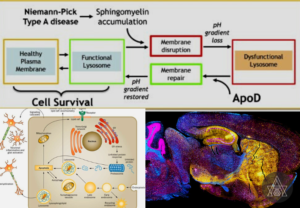Coordination Of The Body
Process of nerve conduction
Since nerve conduction involves electricity created from chemical molecules, it is an electrochemical process. Nerve conduction play a major role in coordination of the body. In other words, unlike how electrons flow via a conventional electrical cable, the brain does not make electricity. The flow of electrically charged molecules through the membranes of the neurons is what actually generates the brain’s electricity.
Like any other cell, a neuron has microscopic openings called channels in its membrane. Charged molecules enter and exit the neuronal membrane through these channels.
The channels in neurons, however, are so specific to that they can orchestrate the flow of these ions across the membrane in order to conduct nerve impulses, in contrast to the channels in other cells.
Every live cell maintains a gap in the electrical fields outside and within the cell membrane, or a potential differential across the cell membrane. It is known as membrane potential. The potential of a neuron’s membrane can be altered. The plasma membrane of a neuron possesses a negative charge in comparison to its surroundings under normal circumstances. The resting potential is referred to as this normal condition.
There are four ions within the cell cause to resting potential. Those are,
Potassium
Sodium
Chloride
Carboxylate
While Chloride and Sodium ion concentrations are higher external environment of the cell, potassium ion (K+) as well as carboxylate ion concentrations are higher within the cell. K+ ions can pass through the axon membrane more easily than other ions can while the cell is at rest. Since there are fewer positive ions inside the cell as a result of the K+ ion diffusing out quickly, the environment inside is slightly less positive. The ratio of potassium ions leaving and entering the cell eventually balances out. The resting potential is produced by this K+ ion migration. A membrane is referred to as polarized when it is in this state. A neurons becomes depolarized when it is activated, altering the electrical potential of its cell membrane.
Depolarization alters the membrane’s susceptibility to Na+ ions at the stimulation point, resulting in a rapid flow of Na+ into the axon of the nerve cell. The internal charge of the cell is now generally more positive. It is known as action potential.
The permeability of the membrane to Na+ greatly declines in favor of the K+ ions if enough Na+ have entered to generate a positive(+) charge inside the axon.
This potassium ion flow continues till the resting potential is reached, at which point the ion concentration in this area of the axon is restored and the membrane is repolarized. An nearby region of the membrane’s polarization is depolarized as the concentration in the first section is restored. Reaction of ion transfer is repeated. These localized reactions initiate at the axon’s initial stimulation location. Localized ion transfer reactions spread outward from the initial reaction.
Through a process of action potentials accompanied by resting potentials that are repeated at regular intervals, these reactions propagate potentials. By moving ions between both the axon and its surrounding environment, electrochemical or nervous impulses can travel the entire length of the axons in this manner.

Mechanism of action of the hormones
Hormones are directly released into the surrounding by endocrine glands. Hormones produce by the endocrine system also important to coordination of the body. After that the hormones flow through capillaries to the bloodstream, where they enter the bloodstream and arrive at the desired cells. This permits hormones to affect tissues and organs that are located far from the site of production or to have broad effects on the whole body.
Typically, hormone-producing cells are specialized and found in a single endocrine gland, such as the thyroid glands thryocytes. Exocytosis, or another method of membrane transport, is how hormones leave the cell from whence they were produced. One or more types of cells that are found in a variety of tissues could be the cellular recipients of a certain hormone signal.
Same hormone input may also cause distinct responses in various tissue types. Hormonal signaling is therefore complex and challenging to understand. In order to contact a receptor protein in the cytoplasm of the cell or to bind a specific receptor protein in the target cell’s cell membrane, hormones either diffuse over the plasma membrane of the targeted cell to activate it (water-soluble proteins). In both situations, the hormone combination will set off a series of internal molecular happenings that will cause the nucleus to express its genes.

The function of endocrine system and nerve system in the maintenance of homeostasis in the body
Endocrine system and the nervous system help to coordination of the body as following description.
For an organism to perform the body processes regularly and efficiently, its biochemical systems must be in a state of balance, health, and stability. The endocrine system’s key mechanism, homeostasis, integrates biological processes and keeps the composition of the body fluids that surround the constituent cells constant.
The pancreas secretes hormones like glucagon and insulin, for instance. Together, they maintain steady blood sugar levels. If a specific hormone is present in excess of or below the permitted parameters, a person’s blood sugar levels may rise or fall.
To regulate a person’s blood sugar levels, insulin and glucagon must be in balance. In the liver, glucose is produced by glycogen. When blood glucose enters the cells due to insulin, it is used by the cells to create energy.
Homeostasis, or the stable state of conditions within the body, is a function of both insulin and glucagon. Additional insulin is secreted by the pancreas when blood sugar levels are too high. The pancreas generates glucagon to increase blood sugar levels when they fall.
Of all the body systems, the nervous system is the one that controls homeostasis the most. It offers monitoring, response, and regulation for all systems within the human body as well as other species. It begins by affecting a single cell and eventually has an impact on the entire body.
The environment is constantly being watched and changed by receptors both inside and outside the body. When a person’s body departs from a suitable point and travels outside of its typical range of functioning, signals are sent through the brain system. The system returns to its typical performance range as a result of these responses. In this way, homeostasis functions. These sophisticated and challenging procedures have evolved over millions of years.
For instance, mechanoreceptors and thermoreceptors in the skin each detect changes in pressure and temperature. After that, signals sent from such receptors to the brain allow the detection of situations that could cause harm or death. Additionally, nerves trigger muscle contractions, which move the bones in the skeleton and enable an organism to fight or run away from predators. The capacity to feel the environment and react to it is essential for maintaining homeostasis in the body.
The neurological system and the endocrine system are in charge of coordinating the body’s processes, as stated above. The endocrine and neurological systems both provide messages to the functional glands, tissues, or organs to maintain the body’s homeostasis in equilibrium. Glands make up the endocrine system. The nervous system is composed of the central nervous system and several peripheral nerves. The main difference between the neurological and endocrine systems is that the former delivers hormones to the effector organ through the blood, whilst the latter delivers electric pulses to the effector organ through neurons. The body gradually assimilates the messages sent by the endocrine system. The neurological system responds in a relatively short period of time.





